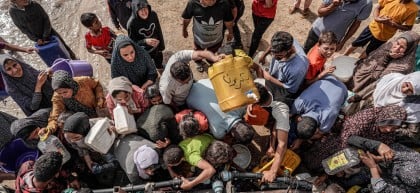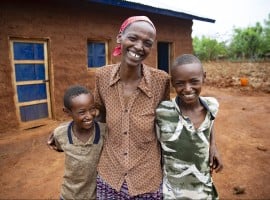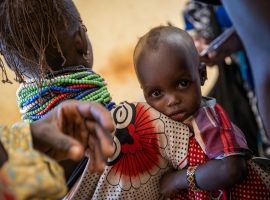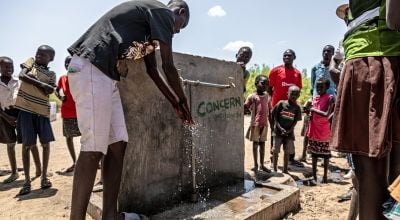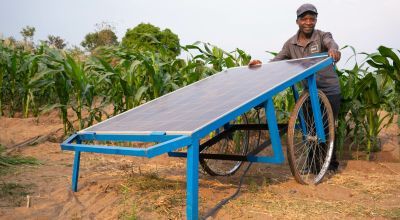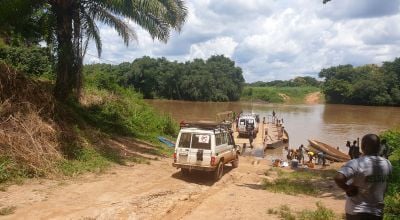
Read our 2023 annual report

Knowledge Hub
A full 25% of the world’s population faces some form of water stress or scarcity.
While we may associate these communities with desert and drought, that doesn’t tell the full story. The basic fact is that we need clean, safely-managed water in order to live.
Unfortunately, that fundamental right is not being met around the world. In these 10 countries, as recorded by the WHO and UNICEF, the need is especially acute.
1. Central African Republic

Despite considerable resources, including access to two of Africa’s most important water basins (the Chari and Ubangi Rivers), only 30.17% of Central Africans have access to basic drinking water — and just 6.13% have access to safely-managed drinking water.
There are overlapping forces at play: the Central African Republic’s population has quadrupled since 1960, rising from 1.5 million then to just over 6 million as of last year. The water infrastructure is outdated, both in terms of technology and capacity, and conditions became worse starting in 2012 with conflict that at times specifically targeted water access points and wells. CAR also lacks a national sanitation and water treatment system, leaving just half a percent of residents with access to basic sanitation.
» Learn more about how Concern is improving water access in the Central African Republic
2. Democratic Republic of the Congo

Decades of crisis in the Democratic Republic of the Congo have left nearly 75% of the country’s population without access to clean drinking water (and just under 12% with access to safely-managed drinking water). More than 97% of the population are also without basic sanitation services. Like the Central African Republic, the Democratic Republic of the Congo has a wealth of freshwater resources, including 62% of the Congo River basin. However, underdevelopment over the last 65 years, combined with both national and localised conflicts, mean under-serviced sanitation needs that lead in turn to contaminated drinking water. The UN’s Environment Programme also warns that the situation may become worse if the climate crisis continues at pace.
With an increase in violence in eastern DRC beginning in late 2023 and continuing in 2025, Concern has been responding by providing over 1.5 million litres of drinking water each day to civilians affected by the conflict. Water and sanitation have also been central to our work in the country, including in consortium with other organisations. Last year, we reached nearly 385,000 Congolese with water, sanitation, and hygiene-focussed programming.
» Learn more about our recent work in the DRC WASH Consortium
3. Ethiopia

Ethiopia recently came out of one of the worst droughts in decades, and has faced increased water shortages as a result of climate change. This leaves just 38.28% of the country with access to basic drinking water, and only 13.24% with access to safe drinking water.
Sanitation is an even bigger concern, with only 2.12% of the country having access to basic sanitation services (and an additional 7.22% with access to safely-managed sanitation services). Conflicts in the Tigray and Amhara regions over the last five years have also left fetching water a matter of life and death for millions — especially women and girls, who traditionally are the ones to collect water. Poor sanitation has also led to major cholera outbreaks in recent years.
Concern has worked to improve water and sanitation in Ethiopia in both the short and long term. Last year, we reached over 193,000 with our cholera outbreak response, as well as over 120,000 with our ongoing emergency drought response. In addition, we are currently running a programme that helps communities respond in advance to anticipated droughts (which are expected to happen again due to poor rains in several regions), which has over 56,000 enrolled participants.
4. Iraq

According to a report released by UNICEF last August, nearly 3 out of 5 children in Iraq have no access to safe water. It’s also absent in more than half of the country’s schools. The effects of the climate crisis in the region, along with disputes with neighbouring countries, have left 38.64% of Iraqis without access to basic drinking water. Only 45.73% of the country has access to basic sanitation services, which are especially hard to come by in the displacement camps hosting foreign refugees and internally-displaced Iraqis.
Water, sanitation, and hygiene (WASH) are key focuses of Concern’s work in Iraq, where we’ve been active since 2013. Last year, our programme continued to improve both access to and quality of WASH services, reaching over 220,000 vulnerable people in northern Iraq.
5. Chad
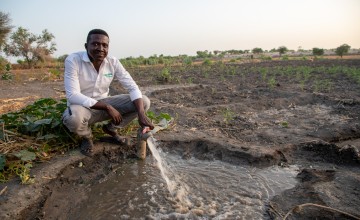
Water scarcity in Chad is especially dire in both the dried-out Lake Chad Basin and, since 2023, the refugee camps hosting hundreds of thousands of Sudanese refugees. Less than half of the country (45.75%) has access to basic drinking water, and just 6.25% have access to safe drinking water. A lack of infrastructure has also left just 2.01% of the country with access to basic sanitation (10.9% have access to safely-managed sanitation services). This is especially critical for young Chadians, who are at higher risk for malnutrition, even if they’re eating enough food, due to waterborne diseases like diarrhoea leading to malabsorption of nutrients.
WASH is a key aspect of Concern’s emergency responses in Chad (including our work within the Sudanese refugee communities). One of our current programmes in Lac province, funded by ECHO, is focused on reinforcing access to quality WASH, nutrition, and protection services for the most vulnerable communities. Scheduled to run through this year, it has over 92,000 participants.
6. Niger

Landlocked and dominated by the Sahara Desert, only one-eighth of the land in Niger is considered arable — an especially large challenge to the workforce, 80% of which relies on agriculture and livestock. Threatened with drought and desertification, the county has also faced recent bouts of violence and political instability, leaving just 48.9% of the country with access to basic drinking water and an even smaller portion — 8.29% — with basic sanitation.
The knock-on effects of these shortages cut across sectors, including economies and livelihoods, health and nutrition, and hunger. As part of an integrated program to build food system resilience and security in the country, Concern has incorporated several WASH activities, including repairing community wells that have reached 2,500 families with safer, cleaner water.
7. Pakistan

Pakistan is among the most water-stressed and scarce countries in the world according to multiple rankings. Both the UN Development Programme and Pakistan Council of Research in Water Resources have also warned that the country could face absolute water scarcity as soon as this year.
While access to water is comparatively higher than other countries on this list, it’s still low with just over 40% of the country having basic drinking water, and 70.53% basic sanitation. Heat traps caused by deforestation, combined with underinvestment in public works, have left 16 million people in Karachi alone without water access.
Concern is very active in WASH programming for Pakistan, particularly with infrastructure support at community and institutional levels. Last year, we implemented three major projects focused on water and sanitation, reaching a total of over 190,000 people across 12 districts. We also responded to the 2024 floods in the country to help prevent the spread of waterborne illnesses.
8. Yemen

Over a decade of conflict and a disproportionate impact of climate change have made Yemen one of the world’s biggest water crises, with more than 50% of the population left without water. Even more (74.32%) of the country lacks basic sanitation services. Relatively few people (19.16%) have access to safely-managed sanitation.
Yemen has also been on the frontlines of the climate crisis, suffering further water scarcity due to erratic rainfalls and droughts. For many of the country’s 4.5 million internally-displaced civilians (about 14% of the population), the conditions for water access are far worse in camps with even less infrastructure, and greater risk for diseases linked to contaminated water. It currently bears the world’s highest cholera burden as a result.
Water and sanitation are key to Concern’s work in Yemen, where we officially launched a programme last year. We’re supporting two IDP camps in Aden Governorate with WASH services, including rehabilitating water wells and building latrines to curb the spread of water-borne diseases. Last year, we reached 17,500 people with our cholera response.
9. Sudan

Before the onset of the conflict in Sudan, approximately 97% of its water use historically went into agriculture (the major industry for the country). This left scarce supplies for drinking, hygiene, and other domestic needs, with over 40% of families lacking basic water services and 67% without basic sanitation. Since April 2023, conflict has further restricted access to water for millions of Sudanese. What’s worse, UNICEF estimates that, in some areas, the combination of conflict-related damage and outdated systems means as much as 40% of water is lost to leakage. At the same time, up to 60% of the population is unable to access health services due to violence, which has led to a surge of waterborne diseases, including a new epidemic of cholera.
Having worked in the country for nearly four decades, Concern has been responding to the ongoing crisis in Sudan, including knock-on effects like the recent cholera outbreak. Last year, we implemented an epidemic response programme that reached nearly 78,000 people. We also constructed and renovated healthcare facilities, set up handwashing stands in areas of high displacement, and trucked in water to give people an immediate supply.
10. Palestine

Access to water in Palestine has historically been difficult, with UNICEF and the WHO estimating pre-2023 access to basic drinking water at just 18.11%, and basic sanitation at 29.33%. The onset of the crisis in Gaza that year dramatically reduced what access there was in the area. Over 90% of Gaza’s water supply is unfit for human consumption due to contamination and damage, and only 40% of the population currently has access to safe drinking water. The collapse of sanitation services has also led to rising cases of waterborne diseases, including cholera and Hepatitis A. Last year, scientists also confirmed traces of polio in water samples.
Concern has been supporting Alliance2015 partner CESVI in its emergency response in Gaza, which as of the end of last year reached nearly 180,000 people with water trucking and an additional 36,000 with WASH rehabilitation. CESVI is also promoting hygiene to reduce the spread of infectious disease in tandem with water distributions.
The global water crisis: Concern’s response
Ensuring access to clean water and sanitation and providing hygiene information and training are key aspects of Concern’s work, with active water, sanitation, and hygiene (WASH) programmes in 18 countries.
Over the last 55 years, we have dug, drilled, and bored thousands of wells in remote and vulnerable communities across dozens of countries, and built countless latrines in their schools and health centres. The hours saved and the illnesses prevented make it one of the most effective things we do.
When drought or displacement prevent access to clean water supplies, we do what it takes to connect communities, including trucking water to temporary tanks and installing pumps in camps. We work hand-in-hand with communities to help them assess the longstanding challenges they face, change behaviours, and ensure water and sanitation infrastructure will be maintained for the long term. And we foster a sense of ownership, build sustainable maintenance practices, and create transparent financial management systems that benefit the community.
